Brandon Dorman

How did you get started with art and illustration?
Doodles when I was younger, and then I kind of started drawing in junior high. I took some art classes in high school and did fairly well with them. After that I said to myself, “Hey, I’m going to college, may as well pick something I like—I don’t know if I’m good at anything else.” I had a paper route when I was younger, but I don’t think you can support yourself on a paper route. So I decided to try art and enrolled in some classes in college. I studied under Leon Parson, who was a big inspiration to me and a really good teacher. Near the end of my college career, eight of us in the class went out to New York with two of our professors—Dan Burr and Scott Franson—and we showed our stuff to an artist rep named Peter Lott. I was set on coming away out of New York with at least one illustration job, but even though I showed my work to a lot of people, I came away and didn’t have anything to say for it. Then a couple days later Peter called and said, “What would you think if we started working together?” I said I’d give it a shot. I was still in school—I had a little under a year left—and just started turning out artwork left and right, to get it into Peter’s hands so he could get it into clients’ hands. From there I got one job, then another job, and I just kind of went from there.
What do you think were the defining factors in getting you from those doodles as a youngster to the artwork you’re producing now?
The key for me was that parents and teachers encouraged me at a young age. I’d go home from school and be drawing pictures while my buddies were out doing something else. People were constantly saying, “Hey, you’re pretty good at this,” which encouraged me to keep trying—to keep making drawings and paintings. You just keep doing it. There were lots of long hours, too, since creating artwork is pretty time-consuming. It’s the same principle as in any field, really. My teacher Leon Parson put it this way: “Talent really is just the ability to persist until you get it right.” Most people say, “I wish I could draw.” And I say, “You can—you just have to put in as many hours as I have.” If you added up all the hours, probably half my life has been spent with pencil and paper drawing and painting.
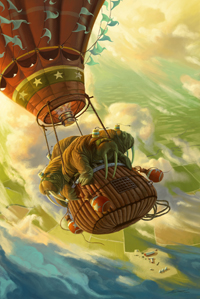
How does a piece of artwork evolve for you?
I mainly work on book covers and picture books, so my rep will email me and say, “Scholastic Books called, and they have a story they’d like you to do the cover for. They’d also like four black and white drawings to go above each chapter.” I’ll ask what the budget and timeline are. If they fit, then they’ll send me the rough draft of the manuscript. I’m a decent reader but if a book’s two or three hundred pages long, it can take me two days or so to read it, so what I’ll often do is have either my wife or my sister or my sisters-in-law or my mom read to me. I rely on them—sometimes I’ll call them and ask, “What happened with this character in this book?”
If the art director gives you direction, you draw up the direction, you give it to them, and you don’t have to think about it. If they don’t, then I have to come up with something out my head. I’ll work up anywhere from one to three sketches and send them to the art directors and the editors to look at. They usually look at it and take it into a meeting, then come back with feedback. They’ll say, “Okay, we want you to change this,” or “We like this, we don’t like this, there’s three sketches here, let’s combine these two.” Now that we’ve determined exactly what we want, I’ll refine the drawing, then send it to them. They’ll send it back, I paint it, and I send it to them. And then they pay me. With life as an illustrator, usually payment is out about two months, so you’ve got to have stuff coming in from what you did before.
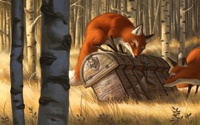
Do you work with traditional media or digital?
I’ve done 100% digital ever since I came out of school. I painted with oil and acrylics in school and I enjoyed having an actual painting versus a bunch of ones and zeros on my computer, but the digital arena is a lot faster. From an illustrator’s perspective, you’ve got to earn money for your family and you’ve got to do jobs weekly. The editor or art director will come back and say, “We like this, but can you tweak her left earlobe?” On the computer I can do that in twenty minutes, save it, and email it to them. If I weren’t using digital, they’d have the final art, they’d have to mail it back to me, I’d have to fix it with my paints, which would probably take me twice as long, and then I’d have to mail it back to them, so we’re out another week—versus half an hour for digital.
Because I’ve been able to take on more jobs than I would have been able to traditionally, I’ve learned more about creating images. And I work from home, so I’m able to leave the door open and my son can run around in here and talk to me and goof around, and he’s not in my paints. But there’s definitely something to be said for having an actual piece of artwork and framing it and hanging it on your wall. A digital print will never be as good-looking as a traditional oil or acrylic painting, or even a pencil drawing. There’s something about the texture of it that’s just magical.
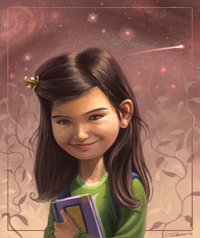
What’s your typical timeline on a book cover?
It really depends. There’s one book I worked on that took six weeks. But then the other day I drew up a sketch and sent it to them; they replied the next day; I started painting that day, then finished it the next day, and the whole job turnaround was three days max. Usually, though, it takes me three days or so to paint, and then there’s waiting for their feedback, which can sometimes take up to a week, but I’ll just work on other stuff while I’m waiting.
You do a lot of fantasy illustrations. Is that a choice you made, or is it just how the jobs have turned out?
I do young adult fantasy, but I’ve kind of been pushed into that genre of work, for two reasons: first, it’s popular right now, and so publishing companies have books that are about magic and the twelve-year-old boy who’s an orphan but finds out that he’s special and has some power, or there’s a twelve-year-old girl who’s lost and she finds a friend who she goes off with on this journey and they find out she’s the ruler of the universe or something. Second, when I started doing books, some of my very first jobs were along those lines. I did that first one, then someone saw it and said, “Could you do this one?” And I did that one and then somebody else saw that one. So here I am starting to work and my first five or six jobs are all young adult fantasy, and when people ask to see my work, of course I’m going to put my work that’s most recent. But I don’t mind—they’re fun to do.
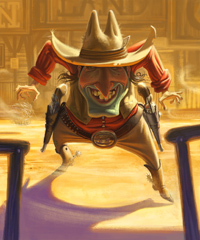
How is painting imaginary things different for you from painting from real life?
I have a really bad habit of painting and drawing out of my head. But it’s one of those double-edged swords, because when I do take a reference picture, I end up copying it exactly. And it’s hard for me to paint realistically—I was in a head painting class one time and I had a lot more fun doing caricatures and distorting things. Now, I’ll look up pictures of things if I need to, but I rarely take a photograph that I’ve taken and copy straight from it. A lot of stuff is out of my head. The weakness there is that you start to draw the same things out of your head—you start to make hands the same, because you’re not looking at different types of hands. You have to try to counteract that. Also, a lot of times you don’t get everything exactly right—noses and faces and things can be out of whack pretty easily when you’re just drawing them out of your head.
What was it like illustrating Christ in In the Garden?
Kind of intimidating. One of my teachers said that before he did a painting of Christ, he cleaned out his whole office. At the time, my workstation was in the bedroom where my wife and I slept, so I got up in the morning and walked about four steps and sat down at work. I’d make an effort to make sure the place was clean. Because of the time thing, though, I was saying to myself, “I’ve got to get this done. This is kind of how I picture Him, and it’s going to be a children’s book, so I probably want to make Him look closer to the stereotypical Christ with the beard and everything.” I did some research but not much. A lot of it was based on how I’d seen him in other paintings. Maybe it’s good that I didn’t sit there and fume and fret about how I was going to paint Him—instead, it was, “I’ve got zero time on this project, so I’ve just got to do it.”
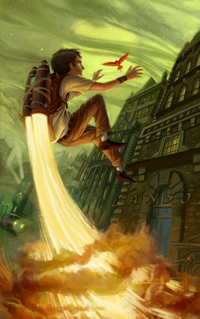
How do you see the gospel influencing both you as an artist and your artwork?
When I see artists do stuff that’s not very moral or tasteful, it turns me off. I almost feel like they’re abusing the talent they’ve developed. The gospel definitely keeps me away from making artwork that is dark—I think being a member of the Church and having a good outlook on life and an understanding of the gospel reflects in your artwork. Now, I am working on the Goosebumps series, which is a horror line. But even then, I’m still making it fairly lighthearted, and that’s because the gospel’s front and center. I have no desire to make distasteful or dark images.
What’s the most satisfying part of your job?
Probably receiving an email from somebody that says, “I picked up your book and our daughter really loves it.” Or going over to somebody else’s house and seeing one of my books on their living room end table or something. It’s nice to know you’ve created something that somebody else enjoys. ❧
